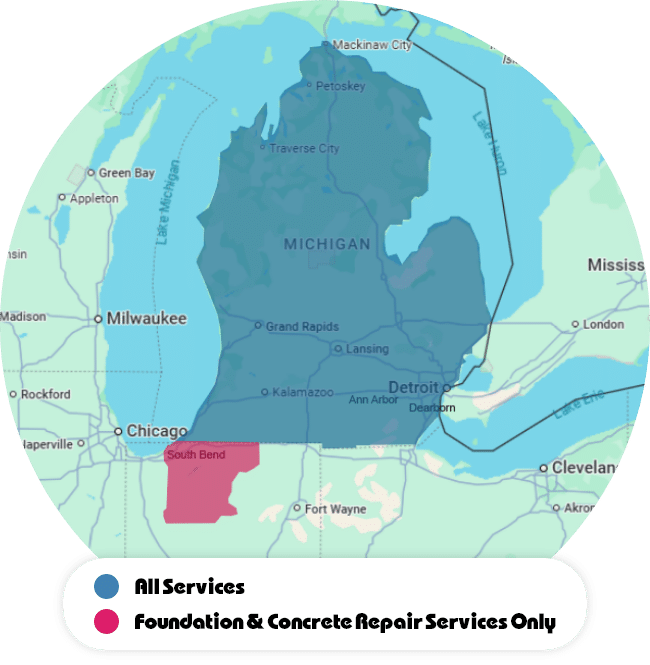Cinder Block Walls vs. Poured Walls
Updated January 2025
In the foundation industry, there is an ongoing debate relating to cinder block foundations versus poured wall foundations. Many individuals are biased towards one wall type or the other. However, like anything else, there are pros and cons to each foundation wall type a person chooses.
Keep reading to learn the difference between these foundation types and how to decide which option is best for your structure.
Cinder Block Walls

Cinder block foundations are formed using a type of cement block and mortar, making them prone to leaks and cracks.
Before the 1970s, cinder block foundations were the most commonly accepted foundation type. Almost every house was built with this style of masonry work. While the poured wall wins for lateral strength, the cinder block wall, when constructed correctly, beats out poured foundation walls for compression strength. This means it can support more weight on top of the foundation. For this reason, a cinder block wall foundation may indeed be the preferred choice of engineers and architects.
Construction of a good cinder block wall does demand more skilled bricklayers, which translates into a higher labor cost. Cinder block wall foundations are more prone to bowing and buckling, and repairs can be costly in the worst-case scenario, where the wall must be rebuilt. While both foundation types can be completely waterproofed, block walls tend to have more leaks because of the significant number of joints they have. Water and weather wear down the mortar over time and can cause leaks.
Poured Concrete Walls

Poured walls have no joints, which makes them stronger and easier to waterproof.
Poured concrete foundation walls are arguably stronger than cinder block foundation walls. Without joints, poured walls possess a greater lateral strength, which essentially means they have a greater ability to resist pressure presented by water and the soil from the outside. A poured concrete wall doesn’t have joints like a cinder block wall, so it should come as no surprise that it is naturally easier to waterproof.
Poured walls tend to be the preferred choice of new construction builders. They can be formed to any foundation design and pose the flexibility of being adapted for last-minute changes. It is faster and more efficient to construct a poured wall, but can be expensive if the place producing the cement is far away. For example, if the concrete trucks must travel farther than an hour and a half, a cinder block wall foundation would likely be the better choice. It really depends on the building circumstances, availability of concrete, and skill level of the construction workers.
We Provide Solutions to Aid Both Foundation Types
Ayers Basement Systems is a trusted foundation repair contractor in Grand Rapids, Lansing, Kalamazoo, and the surrounding area. As a member of the Supportworks and Basement Systems networks, we offer cutting-edge repair solutions for both cinder block and poured foundation walls.
Learn more about how we can strengthen and protect your foundation below.
Foundation Repair Products
- PowerBrace: The PowerBrace is an adjustable brace that improves the condition of bowing and cracked walls. The PowerBrace reverses the forces of nature by reinforcing the wall and allowing it to move back to its original position.
- Carbon Armor: The Carbon Armor system works by utilizing a special epoxy resin to absorb the pressure from the outside soil (which is what causes the bowing in the first place). It's 10x stronger than steel and specifically designed for basement walls.
- Wall Anchors: Wall anchors are perfect for returning a wall back to its original position and reinforcing the entire foundation. We stabilize the home with a steel rod that runs from the wall anchor to an anchor placed in the exterior of the home. Once we place the plates we have permanently stabilized the basement.
Waterproofing Products
- CleanSpace: The CleanSpace vapor barrier is a heavy-duty, thick liner that isolates a home from the earth beneath it. It creates an effective moisture and vapor barrier and captures all wall seepage and leaks. This transforms the space into a clean, usable, and healthy environment.
- WaterGuard: The WaterGuard Below-Floor Drain System protects a home from water leaking near foundation walls. It is designed to catch water seepage through walls and leaks along the wall/floor joint. This product provides a quality solution without the expensive cost of installing an exterior drain system.
- FlexiSpan: FlexiSpan crack repair is a three-part process that begins with the application of a flexible sealant along the full length of the crack. Next, a strip of flexible and porous foam is installed over the crack. Finally, an impermeable membrane is adhered to the wall on both sides of the foam strip.
Making the Right Choice
One foundation choice is not universally the best foundation choice for everyone. When selecting a foundation type, the decision should be based on your unique circumstances now — as well as in the future. Becoming knowledgeable about your options ensures you’ll make an informed decision about the type of foundation that best suits your needs.
Have a foundation repair question? We can help!
Call 1-866-379-1669 or contact us online today to schedule a foundation inspection and estimate! Ayers Basement Systems offers foundation repair throughout Michigan, including Kalamazoo, Lansing, Traverse City, Muskegon, and Grand Rapids, as well as parts of Indiana, including South Bend, La Porte, and Mishawaka.









